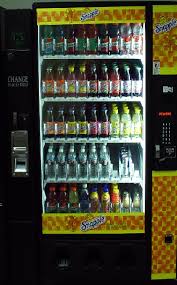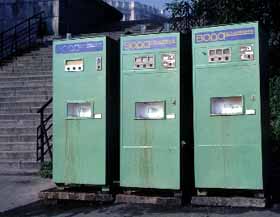Not only snowmen are affected. Lane Bryant has some manequins that even
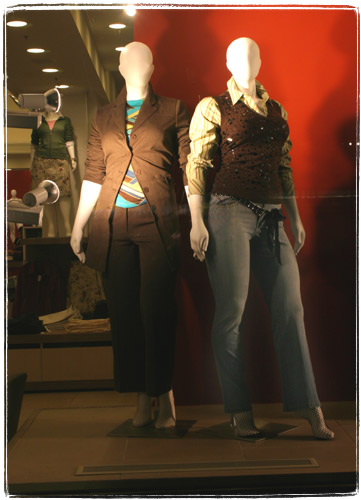
The Ultimate DIY
These days I own some very serious espresso equipment. I am pretty much set with espresso. But one thing is still missing from my kitchen, and that’s a commercial soda fountain.
I do not own a car, which is one of the reasons why I have time and money to purchase the abovementioned espresso equipment. Not having a car, I hate lugging soda bottles from the store , hate running out of soda, hate having to drink warm soda because I forgot to put a few bottles into the fridge. The solution is rather simple – build my own soda fountain.
Indeed there are people crazy enough to put together soda fountains from parts bought on eBay. I might have a better espresso machine, but this guy, for example, has a bar style soda gun right in his kitchen:
This setup is pretty sweet as well :

If you read the explanation from the link above, building your own from eBay parts is a long and messy process, although the price will stay under $1000. There’s a company that sells prereconfigured units, but that costs about 3K. Also all of the soda machines take up a lot of cabinet space, and some require a separate ice cube maker.
I don’t have the time, space or money to attempt a project like this now. But there’s a low rent / low tech alternative called Soda Club. You have to chill bottles with water and then carbonate them in a small tabletop unit. I don’t know looks kind of similar to the iSi syphon and thus lame. Maybe I’ll try it.
Glass or Plastic?
Why, glass, of course. I hate soda sold in plastic bottles. Hate it, hate it, hate it.
Here in New York in many restaurants you can find Coke and rarely Pepsi in glass bottles. Yes, Coke in the original bottle shaped like the cacao tree seed pod instead of the coca seed. They are made in Mexico, I think
“She told me that they were bottled in Mexico and I nodded since I already knew that and said, “I think it is because they use real sugar.”
She shook her head, “No, no, not the sugar. It’s the water.”
She leaned in like she was telling me a secret, “Mexican water is the BEST water in the entire world.”
Just then a smaller woman leaned in beside her grinning with a single eyebrow raised and whispered.
“It’s MAGIC water!”
Apparently it is not Montezuma’s revenge that assails unsuspecting tourists, but the magic waters that sour in the bellies of the unimaginative, somewhere South of the border.”
Remember I mentioned Pepsy Crystal? People called it second New Coke, but I actually liked it. Well, these days it’s a bit more expensive – single can sells for $20-25 on eBay. Overall “coca cola unopened” and “pepsi unopened” bring back very interesting results.
Apparently they still make Moxie and Diet Moxie. Yep, the drink that gave us a word for “ability to face difficulty with spirit and courage“.
Syphon Filter
One of the chores that I had to do weekly when I was little was refilling two large soda syphons in a little kiosk a few blocks away from where we lived in Odessa. You can still buy a soda syphon today, but these are crummy tiny cartridge operated ones. Mine were big metal units that were refilled by what was probably a hundred year old machine operated by a cantankerous old dude or his equally cantankerous wife.
In the kiosk they also sold soda by the glass, adding syrup from a very interesting dispenser that operated on the same principle as a titration buret. The choice of syrups was the same as in soda vending machines.
Once, on a trip to Kiev, my father took me to an amazing giant shop that sold soda. They had a whole forest of those syrup dispensers, all different. The place was operated since before the revolution of 1917 (a huge rarity in the Soviet Union). I remember trying the most delicious tarragon flavored soda.
Actually a very delicious bottled tarragon soda was also sold in the Soviet Union under the brand name “Tarhun”.
Soviet soda was sold in glass bottles with crescent shaped labels. For some weird reason Pepsi was sometimes made available in different bottles with square labels. I’ve never seen a Soviet Coke bottle, but apparently they existed :

I had my first taste of Coke in Moscow in the late eighties in a theater’s concession stand.
The label above and the ones below are from the site of some dude who has an amazing collection of Soviet soda labels. he sells them at $2.50 a pop. I think I’ll buy some. Oooh, these bring back a lot of memories.


One of the neighborhood grocery stores here in Brooklyn once stocked very interesting plastic seltzer bottles from Brazil (I think) that operated as siphons. Iv’e never seen ones like that since.
Close To The Machine
While we are on the topic of vending machines, I gotta mention hacking.
I remember that a trick with a coin with a little hole attached to a string worked on Soviet payphones, but I don’t remember seeing it used on soda machines. I never tried it. Mr Krabs in a Spongebob cartoon about the origin of Krusty Krab did that, sot it’s probably an international “hack”.
At UGO one bright person tried to cheat the Coke machine out of a dollar by applying a long piece of scotch tape to the bill and trying to pull it back out once the machine swallowed it. This broke our subsidized 25 cent machine resulting in an office full of pissed off people. That cost the company a few hundred dollars.
Then there was an interesting machine at iXL – one that dispenses glass bottles of Snapple. There are 5 shelves, and glass bottles fall down and somehow surviving. Somebody figured out that that particular machine checked if the bottle fell to the bottom before taking the money. If one stopped the bottle by holding a flap that swings to protect the dispensing box at the bottom, the machine was tricked into thinking that the bottle did not dispense and let the user make another selection. Everything was fine, but one not very bright individual caught one bottle with the flap and proceeded to drop a second bottle from the top shelf directly overhead. The dispensing bin was immediately filled by glass shards and Snapple.
Some American soda machines have a hidden menu that can be activated by pressing drink buttons in the following order : 4 2 3 1. I activated it once by accident (the dang machine was out of everything) and only now found a reference to this online. Some snack food machine can be induced to show its internal temperature, but I don’t know the key combination.
The company where I work now used to have two presidents at the same time. One liked Coca Cola and another liked Pepsi. Because of that we used to have two vending machines. Now they are both gone and we have only one machine.
And last is but not least : a weird “hack” that some of my classmates used to trick a proprietor of a soda kiosk in Odessa. They cracked a broken fluorescent lamp open and rubbed the white residue found inside on a copper 2 kopek coin. The coin became silvery and could be easily passed off as a 15 kopek coin. What’s that white residue? Deadly mercury.
The Water From The Machine
Here’s another memory of my childhood illustrated by a photograph by the author of Window Shopping in the (Evil?) Empire:
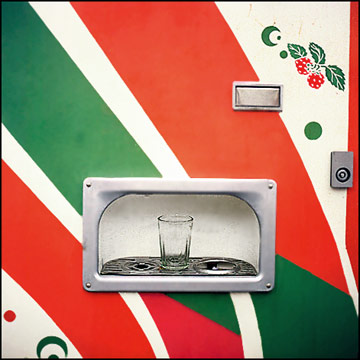
This is a Polish version of the Soviet soda vending machine, an amazing piece of technology.
During Perestroika we got a glimpse of foreign television during the Japanese TV week. If I remember correctly they showed an hour or two of selected Japanese TV shows on one of the three state-run stations. As a curiosity they showed a snippet in which Japanese reporters try to use one of these machines. Equipped with some change, giggling they approached the machine. They put one of the coins into the slot and were surprised by the jet of water from the dispensing nozzle. In Japan one of them explained, the glass drops down from the machine and fills with ice. Then they noticed the communal glass (a paneled one from the previous post) and for a few minutes tried to figure out how to wash it. Then they notices the indentation to the right of the machine. They stuck the glass in there and after a few tries washed it with in the mechanism that shoots little jest of water from underneath. Another coin – soda went into the glass correctly prompting shouts of triumph. I don’t remember if they were brave enough to drink it.
The prices were 1 kopek for plain seltzer and 3 kopeks for seltzer with a shot of syrup. Those with a sweet tooth liked to collect a few shots of syrup which was dispensed prior to the water (technically making it a post-mix machine) and then filling the glass completely. Unscrupulous machine maintainers liked to underdose the syrup helping them to steal some money.
Another one of bright memories was when my father, a civil engineer, took me to his construction site which had one of these soda machines that did not require a kopek to operate – you could drink as much as you wanted. There was no syrup water, but the refrigiration unit was hacked to make it much colder than the machines out in the street. Even visiting Microsoft which has commercial style refrigirators filled with free soda, juices and water did not impress me that much. Oh, and I also got to go up into the cabin of a huge crane (not at Microsoft of course).
Believe it or not, but the company that made these soda machines is still in business. They look like this now:

Tally Me Banana
My wife owns a copy of “The Art Book“. I do not remember which one of us noticed the following brilliant example of art criticism:
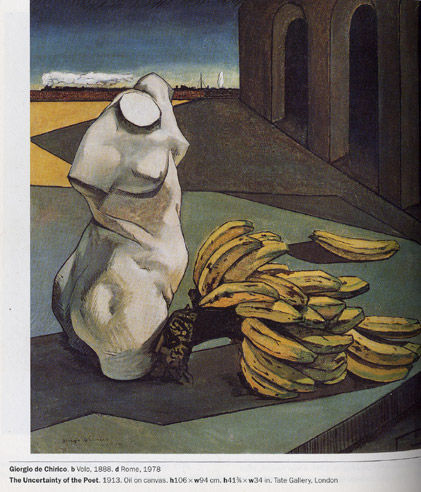
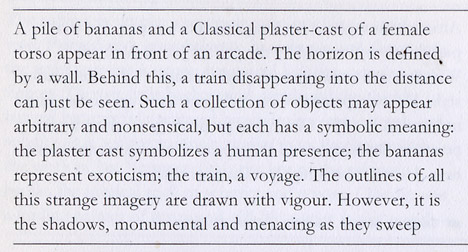
Female torso, bananas, arcade that looks like two tunnels, train. Yep, that all adds up to exotic travel.
What I Learned At Work Today
My cubicle neighbor told me that Krispy Kreme is coming out with a drinkable doughnut. That’s right: doughnuts in liquid form. Great.
Then in the meeting I learned a new word. “Portlet”. A small cute pig is a piglet, a small wave is a wavelet and a small portal is – ta da! – a portlet. Also could be a small port (software, hardware or naval).
That’s it. I just thought I’d share this knowledgelet.
NYC’s Syntactic Sugar
If you buy food from New York’s street vendors long enough you will notice that New Yorkers developed some of what programmers call “syntactic sugar“. As I mentioned in my post about coffee and Greek cups, “coffee, regular” stands for “milk, two spoons of sugar”.
There’s a more extreme example. I gained a bit of weight recently after I started to have “low carb” bagels from a nearby bagel store for breakfast. I highly suspect that those things are a low carb version of non-fat yogurt from that Seinfeld episode. But while having breakfast there I remembered another example of New York’s syntactic sugar. “Bagel, scooped”. From what I hear a scooped bagel is New York-specific.
Here’s how it’s made : the bagel is cut in half, and then each half is hollowed out with tongs. When you put the two halves back together the hollowed out space forms an empty channel inside the bagel. Thus altered topology of the torus is highly conducive to non-falling-out of cream cheese or egg salad. Indeed, a scooped bagel with cream cheese is much easier to eat on the train without violating the rules about littering. (Although I’ve seen MTA ad signs that say that eating in subway is prohibited there seems to be no rule against eating and drinking non-alocoholic beverages in the Rules of Conduct).
Gastronautic Updates
I wrote about the caterpillar infecting fungus called cordyceps, right? Well I went to one of the herbalist shops on Avenue U and purchased $40 dollars worth. In fact that was the smallest amount I could buy since the damned fungi cost about $200 an ounce.
Here’s about a quarter of my haul:
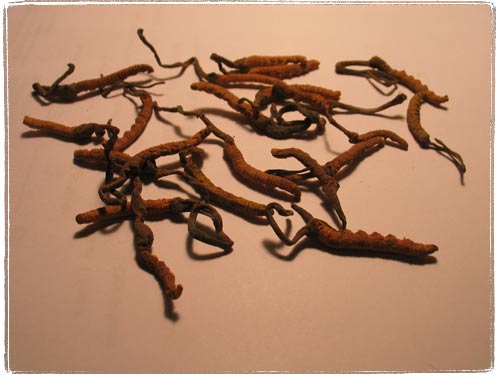
They smell faintly of chocolate and dust. The caterpillar part tastes like cardboard and dust. The protruding fungus has a tingly – sour taste, not unpleasant at all. I did not notice any health effect.
Moving on. I also wrote about a corn infecting fungus that the Mexicans call Cuitlacoche. I ordered a can of Monteblanco brand Cuitlacoche through Amazon and Mexgrocer.
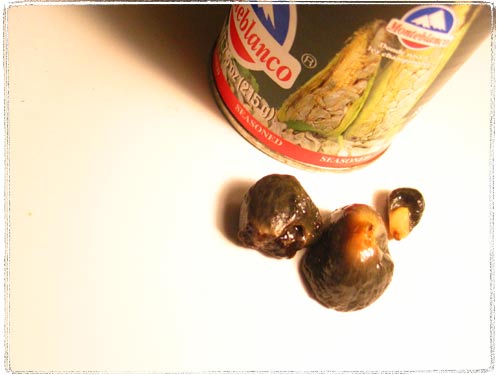
The giant fungus infected corn kernels have a texture similar to slippery jack mushrooms and a slightly smoky flavor. The ingredients include onions , jalapeno peppers and epazote ( Skunkweed aka Wormseed, aka Mexican tea aka West Indian goosefoot aka Jerusalem parsley aka Hedge mustard aka Sweet pigweed which supposedly has “antiflatulent powers” ) which kind of make it hard to say what it really tastes like on its own.

